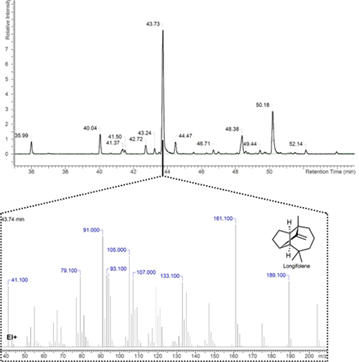Chemical Analysis With Speciation
What is it?
Different instrumentation can be applied for this purpose: the main technique Gas Chromatography coupled with Mass Spectrometry (GC-MS). GC - MS is a technique that combines the separation capability of gas chromatography (GC) with mass spectrometry (MS), which allows for the identification of the separated compounds (Figure 1).
So, we obtain a chromatogram, a diagram where we can observe different peaks, each peak attributable to the different molecules separated by the GC column in function of time (Figure 2). Under every chromatographic peak, it is possible to analyse the mass spectrum and identify every substance.
Background
Chemical analysis with GC-MS is an “old” and consolidated technique and is historically the first method applied for odour analysis. However, it cannot be considered as a method developed specifically for odour measurement. Although the type of information obtained with this kind of analysis can be very accurate, it's not directly related to odour perception.What can it be used for?
Chemical characterization also allows to evaluate compliance of the emissions with regulatory concentration or flux limits that are fixed by the competent authorities in order to protect workers and citizens from exposure to hazardous or toxic compounds.

Figure 2. Chromatogram (top) and mass spectrum (bottom)
What can it NOT be used for?
Chemical analysis can turn out to be very difficult and not always effective, especially in the characterization of complex odours. Odours are not additive: in odorous mixtures, synergistic and masking effects between different odorants may occur, giving that the chemical composition of an odorous sample can not be related to its odour concentration.
One way to relate the chemical composition of an odorous mixture to its odour concentration is to evaluate the so called “Odour Activity Value” (OAV), which is calculated as the sum of the ratio between the chemical concentration of each compound in the mixture and its odour threshold concentration:
OAV = Odour Activity Value (ouE m-3)
Ci = Concentration of compound i (mg m-3)
OTi = Odour Threshold of compound i (mg ouE-1)
However, the odour concentration calculated through the OAV can be very imprecise. One reason for this imprecision is the difficulty of finding reliable OT values, given that the values that are found in literature for a single odorous compound often differ by several orders of magnitude. Moreover, if synergic effects of odorous compounds are present, such a calculation will underestimate the odour concentration of the odorous mixture.
Finally, analytical techniques are not as sensitive as human nose to detect all malodorous compounds. Indeed, there are some odorous compounds that have odour threshold concentrations in the range of ppb (parts per billion) o even ppt (parts per trillion), which are levels that are hardly detected by instrumental methods.
